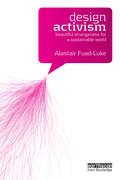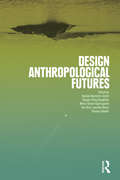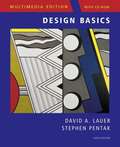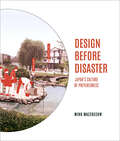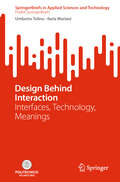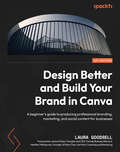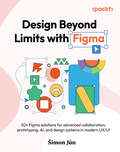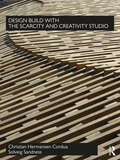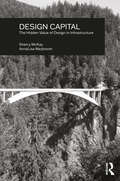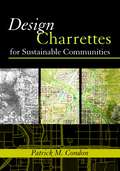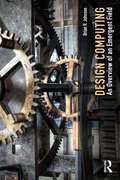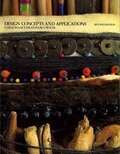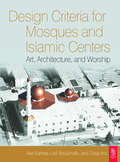- Table View
- List View
Design Activism: Beautiful Strangeness for a Sustainable World
by Alastair Fuad-LukeDesign academics and practitioners are facing a multiplicity of challenges in a dynamic, complex, world moving faster than the current design paradigm which is largely tied to the values and imperatives of commercial enterprise. Current education and practice need to evolve to ensure that the discipline of design meets sustainability drivers and equips students, teachers and professionals for the near-future. New approaches, methods and tools are urgently required as sustainability expands the context for design and what it means to be a 'designer'. Design activists, who comprise a diverse range of designers, teachers and other actors, are setting new ambitions for design. They seek to fundamentally challenge how, where and when design can catalyse positive impacts to address sustainability. They are also challenging who can utilise the power of the design process. To date, examination of contemporary and emergent design activism is poorly represented in the literature. This book will provide a rigorous exploration of design activism that will re-vitalise the design debate and provide a solid platform for students, teachers, design professionals and other disciplines interested in transformative (design) activism. Design Activism provides a comprehensive study of contemporary and emergent design activism. This activism has a dual aim - to make positive impacts towards more sustainable ways of living and working; and to challenge and reinvigorate design praxis,. It will collate, synthesise and analyse design activist approaches, processes, methods, tools and inspirational examples/outcomes from disparate sources and, in doing so, will create a specific canon of work to illuminate contemporary design discourse. Design Activism reveals the power of design for positive social and environmental change, design with a central activist role in the sustainability challenge. Inspired by past design activists and set against the context of global-local tensions, expressions of design activism are mapped. The nature of contemporary design activism is explored, from individual/collective action to the infrastructure that supports it generating powerful participatory design approaches, a diverse toolbox and inspirational outcomes. This is design as a political and social act, design to enable adaptive societal capacity for co-futuring.
Design Aesthetics: Theoretical Basics and Studies in Implication (Design Thinking, Design Theory Ser.)
by Mads Nygaard FolkmannAn original exploration of the role of aesthetics in contemporary design, uniquely combining philosophical aesthetics and cultural analysis of design.As a product of human ingenuity, design functions as an artificial interface through which we meet the world. While the ubiquity of design seems to render it imperceptible, when we truly reflect on design, we see that it is inextricably entwined with our experience of the world. In Design Aesthetics, Mads Nygaard Folkmann provides an engaging introduction to the field of design aesthetics and its role as a concept. Engaging with sensual, conceptual, and contextual considerations of design aesthetics, this book investigates design experience in tandem with design practice, objects, and perception.Part one of Design Aesthetics lays the theoretical foundation by differentiating between sensual, conceptual, and contextual dimensions of design aesthetics and clarifying what &“aesthetic experience&” means in relation to design. The second part of the book consists of studies in implications of design aesthetics for design practice, design objects with embedded technology, and the construction of perception of aesthetic qualities in objects. In its focus on design aesthetics, the book is intended for everyone working with design—design students, designer researchers, and designers—as well as students and researchers in aesthetics in general.
Design After Decline
by Brent D. RyanAlmost fifty years ago, America's industrial cities--Detroit, Philadelphia, Cleveland, Baltimore, and others--began shedding people and jobs. Today they are littered with tens of thousands of abandoned houses, shuttered factories, and vacant lots. With population and housing losses continuing in the wake of the 2007 financial crisis, the future of neighborhoods in these places is precarious. How we will rebuild shrinking cities and what urban design vision will guide their future remain contentious and unknown.In Design After Decline, Brent D. Ryan reveals the fraught and intermittently successful efforts of architects, planners, and city officials to rebuild shrinking cities following mid-century urban renewal. With modern architecture in disrepute, federal funds scarce, and architects and planners disengaged, politicians and developers were left to pick up the pieces. In twin narratives, Ryan describes how America's two largest shrinking cities, Detroit and Philadelphia, faced the challenge of design after decline in dramatically different ways. While Detroit allowed developers to carve up the cityscape into suburban enclaves, Philadelphia brought back 1960s-style land condemnation for benevolent social purposes. Both Detroit and Philadelphia "succeeded" in rebuilding but at the cost of innovative urban design and planning.Ryan proposes that the unprecedented crisis facing these cities today requires a revival of the visionary thinking found in the best modernist urban design, tempered with the lessons gained from post-1960s community planning. Depicting the ideal shrinking city as a shifting patchwork of open and settled areas, Ryan concludes that accepting the inevitable decline and abandonment of some neighborhoods, while rebuilding others as new neighborhoods with innovative design and planning, can reignite modernism's spirit of optimism and shape a brighter future for shrinking cities and their residents.
Design Against Racism: Creating Work That Transforms Communities
by Omari SouzaA historical and philosophical exploration of the impact of design on underserved communities, examining the field’s shortcomings as well as its potential to create positive change. Through essays that delve into history and practice, and case studies that demonstrate practical strategies, Design Against Racism explores how designers of all disciplines can address, through their work, the legacies of racism and oppression.Design profoundly influences culture. The heart of this book is its powerful blend of essays on design history, illustrated case studies, and discussions of practical methods to approach design work, adapted from the restorative justice movement. It explores how design as a professional practice and academic discipline directly affects historically excluded communities, offering frameworks and examples that foster collective improvement. Topics from author Omari Souza, founder of the annual State of Black Design conference, and contributing design professionals include: Unveiling the White Gaze: The Narrative of Whiteness and Colonial Nostalgia Language as a Tool for Marginalization—and Resistance Hip-Hop Architecture: Transforming Spaces through Culture and Innovation Afrofuturism as a Design Strategy Whose Knowledge Is It? Reclaiming Histories, Narratives, and the Plurality of Knowledge Nonhierarchical Engagement with Communities—Anti-Racist Design Community Pop-Up This is a critique of design and a practical handbook that will teach designers and educators how a restorative justice approach can transform their design practice to counteract and fight racism.TIMELY AND ESSENTIAL TOPICS: Thought-provoking essays from leaders in design diversity offer an anti-racist approach to design practice based in an understanding of history, a focus on community building, and a commitment to inclusion. AUTHOR & CONTRIBUTORS: Omari Souza is an Assistant Professor of Communication Design at the University of North Texas and co-host of the highly acclaimed minisode podcast The Design of Business | The Business of Design. Contributors include preeminent design professionals George Fourlas, Shamika Klassen, Kaleena Sales, Zariah Cameron, Lesley-Ann Noel, Cassini Nazir, Yolanda A. Rankin, Soniyah Robinson, and Danielle Lake.Perfect for: Student and professional design practitioners of all disciplines, including graphic designers, product designers, architects, and more Course adoption for design programs Anyone eager to explore the themes of anti-racism and decolonizing design
Design Anthropological Futures: Exploring Emergence, Intervention And Formation (Criminal Practice Ser.)
by Ton Otto Rachel Charlotte Smith Kasper Tang Vangkilde Joachim Halse Thomas Binder Mette Gislev KjærsgaardA major contribution to the field, this ground-breaking book explores design anthropology’s focus on futures and future-making. Examining what design anthropology is and what it is becoming, the authors push the frontiers of the discipline and reveal both the challenges for and the potential of this rapidly growing transdisciplinary field.Divided into four sections – Ethnographies of the Possible, Interventionist Speculation, Collaborative Formation of Issues, and Engaging Things – the book develops readers’ understanding of the central theoretical and methodological aspects of future knowledge production in design anthropology. Bringing together renowned scholars such as George Marcus and Alison Clarke with young experimental design anthropologists from countries such as Denmark, Sweden, Austria, Brazil, the UK, and the United States, the sixteen chapters offer an unparalleled breadth of theoretical reflections and rich empirical case studies.Written by those at the forefront of the field, Design Anthropological Futures is destined to become a defining text for this growing discipline. A unique resource for students, scholars, and practitioners in design anthropology, design, architecture, material culture studies, and related fields.
Design Anthropology: Theory and Practice (Criminal Practice Ser.)
by Ton Otto Rachel Charlotte Smith Wendy GunnDesign is a key site of cultural production and change in contemporary society. Anthropologists have been involved in design projects for several decades but only recently a new field of inquiry has emerged which aims to integrate the strengths of design thinking and anthropological research.This book is written by anthropologists who actively participate in the development of design anthropology. Comprising both cutting-edge explorations and theoretical reflections, it provides a much-needed introduction to the concepts, methods, practices and challenges of the new field. Design Anthropology moves from observation and interpretation to collaboration, intervention and co-creation. Its practitioners participate in multidisciplinary design teams working towards concrete solutions for problems that are sometimes ill-defined. The authors address the critical potential of design anthropology in a wide range of design activities across the globe and query the impact of design on the discipline of anthropology.This volume will appeal to new and experienced practitioners in the field as well as to students of anthropology, innovation, science and technology studies, and a wide range of design studies focusing on user participation, innovation, and collaborative research.
Design Art Deco Quilts: Mix & Match Simple Geometric Shapes
by Don LinnThese bold, stylized quilts are the perfect way to show off fabrics with strong colors. Everything your customers need to create an Art Deco masterpiece is here, from help with choosing the right fabrics for an authentic Art Deco look to estimating yardage, cutting fabric and planning the piecing. Striking quilts inspired by 1930s Art Deco style help you sell bold solid fabrics, as well as subtle background prints. Simple geometric shapes mix and match into original, one-of-a-kind designs Complete instructions for a sample quilt take customers step by step through planning, designing, and piecing. Includes photo gallery of 11 stunning quilts created by student quilters, plus a visual history of Art Deco style and architecture.
Design Basics
by David A. Lauer Stephen PentakFilled with hundreds of stunning examples of successful two-dimensional design, this how-to book explains design theory and gives students the tools needed to create successful designs. DESIGN BASICS presents art fundamentals concepts in full two- to four-page spreads, making the text practical and easy for students to refer to while they work.
Design Basics (Mindtap Course List)
by David A. Lauer Stephen PentakFilled with hundreds of stunning examples of successful two-dimensional design, this how-to book explains design theory and gives students the tools needed to create successful designs. Design Basics 9e presents art fundamentals concepts in full two- to four-page spreads, making the text practical and easy for students to refer to while they work. <P><P><i>Advisory: Bookshare has learned that this book offers only partial accessibility. We have kept it in the collection because it is useful for some of our members. Benetech is actively working on projects to improve accessibility issues such as these.</i>
Design Basics Index
by Jim KrauseMaster the 3 C's of Head-Turning Design!<p><p> Cover your basics with the book that covers everything from typography and color to layout and business issues! Jim Krause, author of the popular Index series, guides you through the understanding and practice of the three elements every successful visual design must have:<p> Components: Learn how to get the most out of the photos, illustrations, icons, typography, linework, decoration, borders and backgrounds you use within your design.<p> Composition: Practice combining the components of a design in a visually appealing way by using the principles of placement, grouping, alignment, flow and spacing to create a pleasing, cohesive design.<p> Concept: Utilize the intangible elements of theme, connotation and style to present and deliver your message in a way that will wow your clients every time. <p> Whether you're a new, mid-level or experienced designer who is brainstorming ideas or finalizing your presentation, this handy-to-use, take-it-with-you book will instruct and inspire you to new heights of creativity.
Design Basics, Multimedia Edition (6th edition)
by David A. Lauer Stephen PentakThe book presents art fundamentals concepts in full two-to four-page spreads, making the text practical and easy for students to refer to while they work and gives instructors the utmost flexibility in organizing the course. Visual examples from many periods, peoples, and cultures are provided for all elements and principles of design, and the diversity of illustrations includes more examples from nature and non-art sources, encouraging students to see these principles in the world around them.
Design Before Disaster: Japan's Culture of Preparedness
by Miho MazereeuwModels of disaster preparedness Across the globe, few sites have faced as many environmental disasters as the islands of the Japanese archipelago. They have endured typhoons, cyclones, floods, earthquakes, volcanic eruptions, and tsunamis. Residents of Japan have responded to their precarious circumstances by developing a unique culture of disaster preparedness, known as bōsai, one that has become embedded in everyday life. It has equipped the island nation to plan for future emergencies and to greatly reduce their impact. In this practical, engaging text, Miho Mazereeuw—who has carried out ethnographic fieldwork and space-based analysis for more than two decades—offers a detailed framework to design and prepare for anticipated disasters and describes effective interventions in urban landscape and architecture. An urgent and timely book, Design Before Disaster represents the cutting edge in disaster mitigation and adaptation to empower communities in the world's most vulnerable places. Publication of this volume was assisted by a grant from Furthermore: a program of the J. M. Kaplan Fund.
Design Behind Interaction: Interfaces, Technology, Meanings (SpringerBriefs in Applied Sciences and Technology)
by Ilaria Mariani Umberto TolinoThis book investigates how digital transformation and technological innovations are challenging traditional design paradigms and redefining the conception of interfaces, suggesting a future where interfaces seamlessly integrate into or disappear within smart objects. Through the lens of Thingk, a university spin-off of the Politecnico di Milano, it addresses the practical application of theoretical design research in creating objects that, while analog in appearance, are technologically augmented, embracing a multidisciplinary approach that includes product design, communication, and interaction design. Covering an eight-year span of experimental design and analysis, it dives into how smart objects leverage context-awareness and situated meanings, engaging users from research and co-creation to validation. The significance of this book lies in its comprehensive analysis and insights into the design process behind such objects, underscoring the need for thorough examination of how semantic reconfigurations impact on affordances and agency. With a strong emphasis on a research-through-design approach and case studies, it bridges theoretical inquiry with practical applications, offering insights into the potentials of design-driven innovation in evolving user experiences.
Design Better and Build Your Brand in Canva: A beginner's guide to producing professional branding, marketing, and social content for businesses
by Laura Goodsell Janine Friston Heather PalfreymanDiscover everything you need to get started with Canva, create a brand, and easily design professional-looking graphics to go from zero to pro in no timeKey FeaturesOrganize your business designs using folders and learn to schedule social media content in Canva's own content plannerLearn to create presentations, as well as video and animated social media postsDiscover the features of Canva to help you save time, including the brand kit, quick create and templatesBook DescriptionIf you're constantly frustrated by how long it takes to create a design in Canva, then you've come to the right place. This book will get you up and running quickly with creating professional branded graphics in Canva. You'll learn how to set up a Canva account, both free and pro and create a brand kit while understanding the importance of branding. Next, you'll discover all the features and tools as well as how to put everything together to build a brand you love and graphics that work for your business. As you progress, the chapters will show you how to organize your account, create presentations, use videos and animation within your marketing materials and more. By the end of this book, you'll have a solid understanding of what Canva is and what it does and be able to confidently and easily create a branded design from scratch.What you will learnUnderstand the fundamental capabilities and features of CanvaCreate a brand kit and understand what makes a good brandDevelop effective graphics to aid in increasing visibility on social media platformsFollow step-by-step tutorials to create stunning designsCreate a branded logo and learn about trademark and copyright guidelinesDiscover a world of color combinations, contrasts, and meanings for your brandExplore the fundamental design principlesUse videos, animation, and sounds in social graphics for your designsWho this book is forThis book is for aspiring designers, social media managers, VAs, service-based businesses and solopreneurs with basic experience in Canva, who are looking to advance in a new skill, while creating their brand and perfecting their social and marketing materials on a budget. A basic understanding of Canva, including setting up a free Canva account, creating a basic design using a template, adding images and text boxes and changing the color of fonts will be helpful but not essential.
Design Beyond Limits with Figma: 50+ Figma solutions for advanced collaboration, prototyping, AI, and design systems in modern UX/UI
by Šimon JůnBecome a pro Figma user by learning advanced techniques, real-world workflows from experts, and Al tips that make collaboration and handoffs effortlessKey FeaturesLevel up into a highly sought-after designer through expert techniques and battle-tested workflowsLearn faster with a hands-on guide built around practical, recipe-based approach.Put Al to work in Figma with workflows that speed up content, assets, and cleanup while saving hoursPurchase of the print or Kindle book includes a free PDF eBookBook DescriptionFigma isn’t just a design tool; it’s the modern designer’s command center Šimon Jun, COO at Dotidot, longtime Figma lecturer, and organizer of the Czech Friends of Figma community, built this book from the trenches of real product work. After years of untangling messy files, rescuing failing handoffs, and coaching teams at scale, he distilled what actually works into a practical, recipe-driven guide. Over time, Šimon saw the same problems show up again and again: bloated files, broken handoffs, and design systems that couldn’t scale. This book is his way of sharing the patterns, tools, and habits that helped teams move past those roadblocks and build stronger, more connected design processes in Figma. Inside, you’ll learn how to structure files for real collaboration, use design tokens without chaos, build accessible, scalable libraries, and hand off to developers with confidence. You’ll see how to automate repetitive work with plugins and AI, run async reviews, and bake feedback loops into your process so projects keep moving, without losing polish.What you will learnMaster advanced collaboration workflows to reduce rework and keep design projects moving.Build scalable design systems with tokens, variables, and accessible components.Deliver clean handoffs using specs, annotations, exports, and Dev Mode.Create accessible systems that meet WCAG standards and work at scale.Engage stakeholders effectively through clear reviews and interactive presentations.Leverage plugins and AI to automate tasks and accelerate design work.Who this book is forThis book is written for UX and UI designers who already have a basic understanding of Figma and want to advance beyond the fundamentals. Product managers and developers who work closely with design teams will also benefit from learning design practices, building scalable systems and better collaboration practices.
Design Build with The Scarcity and Creativity Studio
by Christian Hermansen Cordua Solveig SandnessFrom its creation in January 2012, The Scarcity and Creativity Studio has developed a teaching method which reaffirms a commitment to architecture as a service to society, questions the idea of the individual creator in favour of collaborative design, and challenges the traditional master-student relationship. This book documents the projects and, in so doing, explains the practices and pedagogic methods which the studio has developed in relation to architecture education in general and design build education in particular. Aimed at students, teachers, and professionals who are exploring the possibilities of design build, the 16 built projects are fully documented in text, drawings, and photos and can be used as both inspiration and references. Projects are based in Norway, Finland, Chile, Ecuador (Galápagos), Kenya, South Africa, China, Argentina, and Lebanon.
Design Capital: The Hidden Value of Design in Infrastructure
by AnnaLisa Meyboom Sherry McKayWell-designed infrastructure brings social value that far exceeds its initial construction expenditure, but competition for scarce government funds and a general public perception of infrastructure as mere efficiency, has often left design ill-considered. This book provides designers with the tools needed to argue for the value of design: the ‘design capital’ as the authors term it. In naming and defining design capital, design can once again become part of the discussion and realization of every infrastructure project. Design Capital offers strategies and tools for justifying public spending on design considerations in infrastructure projects. Design has the ability to make infrastructure resonate with cultural or social value, as seen in the case studies, which bestows infrastructure with the potential to accrue design capital. Support for this proposition is drawn from various methodologies of economic valuation and Bourdieu’s theory of cultural capital, explanation of design methodology and education and a series of historical and contemporary case studies. The book also addresses some of the more controversial outcomes associated with contemporary infrastructure: gentrification, globalization and consumer tourism. With this book, designers can make a stronger case for the value of design in public infrastructure.
Design Capital: The Hidden Value of Design in Infrastructure
by AnnaLisa Meyboom Sherry McKayWell-designed infrastructure brings social value that far exceeds its initial construction expenditure, but competition for scarce government funds and a general public perception of infrastructure as mere efficiency, has often left design ill-considered. This book provides designers with the tools needed to argue for the value of design: the ‘design capital’ as the authors term it. In naming and defining design capital, design can once again become part of the discussion and realization of every infrastructure project.Design Capital offers strategies and tools for justifying public spending on design considerations in infrastructure projects. Design has the ability to make infrastructure resonate with cultural or social value, as seen in the case studies, which bestows infrastructure with the potential to accrue design capital. Support for this proposition is drawn from various methodologies of economic valuation and Bourdieu’s theory of cultural capital, explanation of design methodology and education and a series of historical and contemporary case studies. The book also addresses some of the more controversial outcomes associated with contemporary infrastructure: gentrification, globalization and consumer tourism.With this book, designers can make a stronger case for the value of design in public infrastructure.
Design Charrettes for Sustainable Communities
by Patrick M. CondonA step-by-step guide to more synthetic, holistic, and integrated urban design strategies, Design Charrettes for Sustainable Communities is a practical manual to accomplish complex community design decisions and create more green, clean, and equitable communities. The design charrette has become an increasingly popular way to engage the public and stakeholders in public planning, and Design Charrettes for Sustainable Communities shows how citizens and officials can use this tool to change the way they make decisions, especially when addressing issues of the sustainable community. Designed to build consensus and cooperation, a successful charrette produces a design that expresses the values and vision of the community. Patrick Condon outlines the key features of the charrette, an inclusive decision-making process that brings together citizens, designers, public officials, and developers in several days of collaborative workshops. Drawing on years of experience designing sustainable urban environments and bringing together communities for charrettes, Condon's manual provides step-by-step instructions for making this process work to everyone's benefit. He translates emerging sustainable development concepts and problem-solving theory into concrete principles in order to explain what a charrette is, how to organize one, and how to make it work to produce sustainable urban design results.
Design Commons: Practices, Processes and Crossovers (Design Research Foundations)
by Gerhard Bruyns Stavros KousoulasThis book directly links the notion of the commons with different design praxes, and explores their social, cultural, and ecological ramifications. It draws out material conditions in four areas of design interest: social design, commons and culture, ecology and transdisciplinary design. As a collection of positions, the diversity of arguments advances the understanding of the commons as both concepts and modes of thinking, and their material translation when contextualised in the domain of design questions. In other words, it moves abstract social science concepts towards concrete design debates. This text appeals to students, researchers and practitioners working on design in architecture, architecture theory, urbanism, and ecology.
Design Computing and Cognition '14
by John S. Gero Sean HannaThis book details the state-of-the-art of research and development in design computing and design cognition. It features more than 35 papers that were presented at the Sixth International Conference on Design Computing and Cognition, DCC'14, held at University College, London, UK. Inside, readers will find the work of expert researchers and practitioners that explores both advances in theory and application as well as demonstrates the depth and breadth of design computing and design cognition. This interdisciplinary coverage, which includes material from international research groups, examines design synthesis, design cognition, design creativity, design processes, design theory, design grammars, design support and design ideation. Overall, the papers provide a bridge between design computing and design cognition. The confluence of these two fields continues to build the foundation for further advances and leads to an increased understanding of design as an activity whose influence continues to spread. As a result, the book will be of particular interest to researchers, developers and users of advanced computation in design and those who need to gain a better understanding of designing that can be obtained through empirical studies.
Design Computing and Cognition '16
by John. S GeroThis book gathers the peer-reviewed and revised versions of papers from the Seventh International Conference on Design Computing and Cognition (DCC'16), held at Northwestern University, Evanston (Chicago), USA, from 27-29 June 2016. The material presented here reflects cutting-edge design research with a focus on artificial intelligence, cognitive science and computational theories The papers are grouped under the following nine headings, describing advances in theory and applications alike and demonstrating the depth and breadth of design computing and design cognition: Design Creativity; Design Cognition - Design Approaches; Design Support; Design Grammars; Design Cognition - Design Behaviors; Design Processes; Design Synthesis; Design The book will be of particular interest to researchers, developers and users of advanced computation in design across all disciplines, and to all readers who need to gain a better understanding of designing.
Design Computing: An Overview of an Emergent Field
by Brian R. JohnsonDesign Computing will help you understand the rapidly evolving relationship between computing, designers, and the many different environments they create or work in. The book introduces the topic of design computing, and covers the basics of hardware and software, so you don’t need to be an expert. Topics include the fundamentals of digital representation, programming and interfaces for design; the shifting landscape of opportunity and expectation in practice and pedagogy; placing sensors in buildings to measure performance; and the challenge of applying information effectively in design. The book also includes additional reading for those who wish to dig deeper into the subject. Design Computing will provide you with a greater awareness of the issues that permeate the field, opportunities for you to investigate, and perhaps motivation to push the boundaries.
Design Concepts and Applications
by Frank R. Cheatham Jane Hart Cheatham Sheryl Haler OwensDesign Concepts and Applications
Design Criteria for Mosques and Islamic Centres
by Akel Kahera Latif Abdulmalik Craig AnzThe design principles necessary to create functional and dynamic contemporary mosques can be hard to grasp for those unfamiliar with the Islamic faith. 'Design Criteria for Mosques and Islamic Centers' provides an easy-to-use and practical set of guidelines for mosque design, illustrated with 300 line drawings. Case studies of urban mosques in New York, Washington, Boston, and London and Birmingham amongst others, demonstrate how mosques and Islamic centers have evolved to integrate into the urban scenario. The book also compares tenets from Western and Eastern religious and secular philosophies and discusses their relation to architectural creation, place-making, meaning, and identity. The book shows how mosques fulfill multiple faith-based and social roles through their design; it provides a wide-ranging, basic understanding of Islamic liturgical conventions and secular functions to enable architects, designers, and community advocates to work with confidence. 'Design Criteria for Mosques and Islamic Centers' is the first dedicated design guide for mosques and Islamic centers available. • Features case studies from the USA, UK, and Europe• Explains fundamental principles to make it easy to create viable design solutions for these exacting buildings that fulfi ll a range of social and religious roles.
